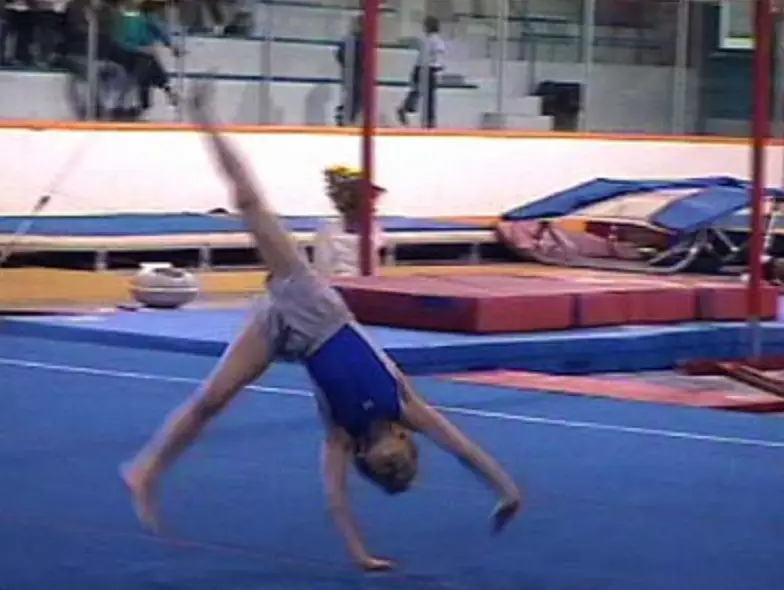A tumbling pass is not a phrase that most artistic gymnastics fans are familiar with, and this is because tumbling passes are not an artistic gymnastics event, they actually belong to the tumbling branch of gymnastics. The tumbling event is a different kind of event where the gymnast gets a little bit of a running start and then does a series of flips and handsprings down a runway to the end.
However, tumbling passes are still used in the floor routines, usually referred to as combination moves, in order to get from one corner of the floor area to another corner. This being the case, it is still good to know what some of these sequences are so that you can work towards memorizing the movements.
Basic Tumbling Passes Combinations
Some Tumbling passes with only two skills:
- Round-off to Back Handspring
- Round-off to Back Tuck
- Round-off to Back Pike
- Front Handspring to Front Tuck
- Front Handspring to Round-off
Some Tumbling passes with three skills:
- Front Tuck to Round-off to Back Handspring
- Front Handspring to Round-off to Back Tuck
- Front Handspring to Round-off to Back Handspring
- Round-off to Back Handspring to Back Tuck
- Round-off to Back Handspring to Back Layout
Single Skills
There are a handful of individual skills that go into these long tumbling passes, and knowing what these are and how they are done are important things to know when it comes to breaking down some of those long names that go with the combination moves. While these are some of the more common skills, almost any of the acro skills that involve turning in the air can be used in the combination of these tumbling passes.
Round-Off
This is a very common skill to see in tumbling passes, especially to start off with in order to gain some momentum and speed. In order to do a round-off you start off with throwing the top part of your body forward and to the ground which you touch with first one hand and then the other while your feet come off of the ground one at a time.

One you are in a handstand position you should be facing the same direction that you where when you were standing, and then you use your momentum to flip yourself forward and back onto your feet again so that you are back into a standing position but facing the opposite direction than you were when you started. This is great for helping your forward momentum, which is why round-offs are so often used in tumbling passes to help the gymnast in this area.
Whip
Also sometimes referred to as the whipback, this is a super-fast type of somersault that looks amazing. Your hands start off at your sides, are thrown back to help your balance as you flip backwards, and then go back to being by your sides before you land. Your legs should be pressed together the entire time and though your body should arch back, there should be no bending.
Essentially this is the exact opposite of a forward straight salto, and the whip can also have variations to it such as a 1/2 turn so that the gymnast is facing the opposite direction when she lands.
Flick-Flack
This is also sometimes called a flip-flop, but perhaps its most common name which most people know it by is a back handspring. In order to do this you first have to do a backbend as quickly as you can for momentum, kicking both of your feet into the air as your hands touch the ground behind you.
All of this momentum that you have is then used in order to keep swinging your legs forward over your body and to the ground as your pull your torso up, resulting in you being back into a standing position again and facing the same direction that you were when you started.
Turning, Twisting, And Combination Somersaults
A double somersault is where the gymnast does a salto and rotates two full times all the way while still in the air which is considered “turning” in the air. This can be done in any of the salto positions whether it is pike, tuck, or even straight. Triple somersaults can also be done, though these are naturally harder to do and are usually reserved until closer to the end of the routine when they gymnast has more momentum going for them.
A “twist” on the other hand, is where the gymnast rotates horizontally while they are doing the somersault instead of end over end like with a turning one. There can be either one, two, or even three twists in a somersault, with the option of 1/2 twists being added to any of these so that the gymnast lands facing the opposite direction than they were when they jumped.
A combination somersault combines both twists and turns in it, making it extremely difficult to do and it is something that requires a lot of control. The twist and turns can be added together however the gymnast wants to, meaning that there can be one twist and two turns, two twists and one turn, or any other combination.
When noting these combination somersaults the twist is always mentioned first. This means that a somersault that has two twists and two turns in it would be called a double twisting double straight somersault. The most that has ever been attempted is a triple twisting triple straight somersault, and very few gymnasts even try to make it to that level.
Tucks, Layouts, And Pikes
However, all of those somersaults are things that you will get to as you gain more practice. The basic forward somersault is often referred to as a front tuck salto, which is often shortened to be simply a front tuck because the legs are in the tuck position. A back tuck is what it is called when you do a backward somersault in the tuck position with your legs together, your knees bent, and your legs held close to your chest.
In fact, the same is also true for the front and back layout as well as the front and the back pike. The difference between these is that the pike ones are done with the gymnast’s leg in the pike position where they are bent straight out in front so that the gymnast’s body forms a 90 degree angle. The layout ones, on the other hand, are of course done with the gymnast in the layout position which is as perfectly straight as possible.
One of the easiest of the somersaults to add twists and turns to is the tucked one, since it has the most aerodynamics working for it and it keeps your legs further up off of the ground. On the other hand, the hardest of the somersaults to add twists and tucks to is the layout, since it is much harder to flip feet over head in this position. The pike position fits nicely in between these two.
Putting Them All Together
In order for something to be considered a tumbling pass there must be a combination of at least two moves. This being the case, even something that only combines two things is still a tumbling pass. A very basic tumbling pass, but still a tumbling pass nevertheless.
At the end of the tumbling pass, there is one end skill that finishes the gymnast’s routine. This final skill in the higher levels is usually either a double or triple somersault, a twisting somersault, or a combination one. These kinds of somersaults are also added as a way to transition in between a couple of the other moves in a tumbling pass, and sometimes are used with a 1/2 twist in order to change the direction the gymnast is facing in preparation for the next move.
In artistic gymnastics tumbling passes generally stay somewhere around 3 combined skills. In the tumbling gymnastics, however, most tumbling passes are made up of around 8 different move combined.

